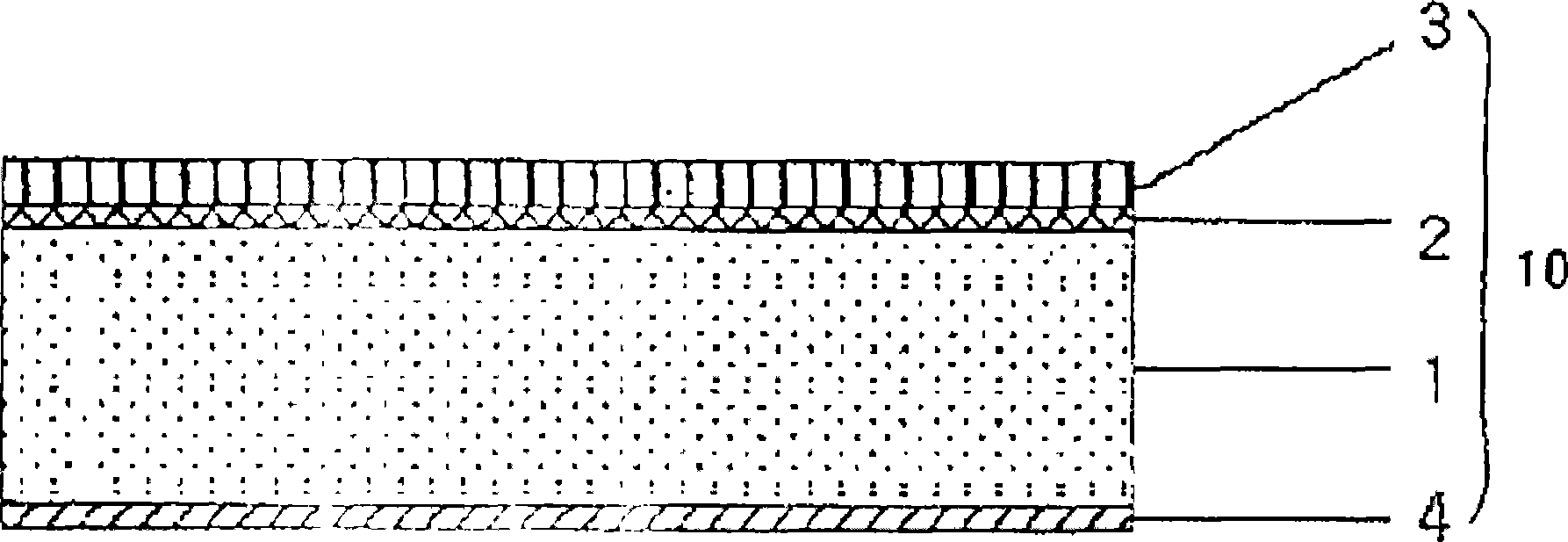Antistatic tapes and method for producing thereof
An antistatic, antistatic layer technology, applied in conductive adhesives, optics, transportation and packaging, etc., can solve the problems of static electricity, dust sticking to the surface of the belt, and static electricity on the adhesive surface cannot be avoided, so as to achieve good durability Receptivity, the effect of maintaining antistatic properties
- Summary
- Abstract
- Description
- Claims
- Application Information
AI Technical Summary
Problems solved by technology
Method used
Image
Examples
Embodiment 1
[0040] Dissolve 10 g of 3,4-polyethylenedioxythiophene dispersion, 30 g of 30% methoxyformamide solution, 0.2 g of p-toluenesulfonic acid, 0.01 g of Zonyl (Dupont Co.) and 0.2 g of ethylene glycol into 60 g of a mixed solution of ethanol and isopropanol. The resulting solution was coated on a polyester film, followed by drying at 100° C. for 2 minutes. The film thus prepared had a surface resistivity of 10 as measured by the ASTM D3359 standard test method. 5 Ohm / square meter, adhesion is 5B. The prepared film had a transmittance of 98% at a wavelength of 550 nm. The film was then coated with an adhesive component and left to stand for 5 days with a resistivity of 10 5 ohms / square meter.
[0041] A 5 micron thick epoxy adhesive layer was also formed on the prepared conductive polymer film. The surface resistivity of the adhesive layer was measured to be 10 8 ohms / square meter.
Embodiment 2
[0043] 3.5 millimoles of 3,4-ethylenedioxythiophene, 8.1 millimoles of iron tosylate and 2.3 millimoles of ethanol were dissolved in 15 grams of ethanol. The solution was coated on a polyester film at a thickness of 1.5 μm and then placed in a thermal circulation oven at 100° C. for 2 minutes to induce the reaction. After the reaction was completed, the film was taken out of the oven, and its surface was washed with ethanol and dried, thereby preparing a transparent antistatic film. The surface resistivity of the prepared film was 10 3 ohms / square meter.
[0044] A 5 micron thick epoxy adhesive layer was also formed on the prepared conductive polymer film. The surface resistivity of the adhesive layer was measured to be 10 8 ohms / square meter.
Embodiment 3
[0046] 5 parts by weight of iron toluenesulfonate as an oxidizing agent and a dopant were dissolved in 95 parts by weight of n-butanol. The solution was coated on a polyester film and dried in an oven at 80 °C for about 1 min. The resulting film coated with oxidant and dopant was reacted in a closed chamber filled with a gaseous mixture solution of 3,4-ethylenedioxythiophene monomer and ethanol. At this time, the mixing ratio of 3,4-ethylenedioxythiophene monomer and ethanol was 5:5. The temperature in the chamber is about 50° C., and the reaction time is about 5 minutes. Conductive polymer films were produced under the reaction conditions. The surface resistivity of the prepared conductive polymer film is 10 5 ohms / square meter.
[0047] A 5 micron thick epoxy adhesive layer was also formed on the prepared conductive polymer film. The surface resistivity of the adhesive layer was measured to be 10 9 ohms / square meter.
PUM
| Property | Measurement | Unit |
|---|---|---|
| thickness | aaaaa | aaaaa |
| thickness | aaaaa | aaaaa |
| adhesivity | aaaaa | aaaaa |
Abstract
Description
Claims
Application Information
 Login to View More
Login to View More - R&D
- Intellectual Property
- Life Sciences
- Materials
- Tech Scout
- Unparalleled Data Quality
- Higher Quality Content
- 60% Fewer Hallucinations
Browse by: Latest US Patents, China's latest patents, Technical Efficacy Thesaurus, Application Domain, Technology Topic, Popular Technical Reports.
© 2025 PatSnap. All rights reserved.Legal|Privacy policy|Modern Slavery Act Transparency Statement|Sitemap|About US| Contact US: help@patsnap.com

